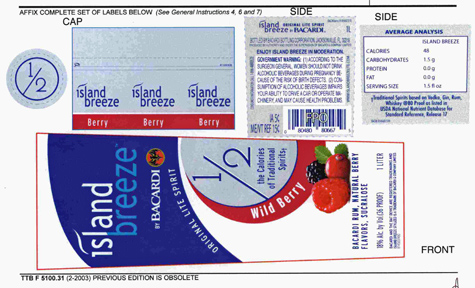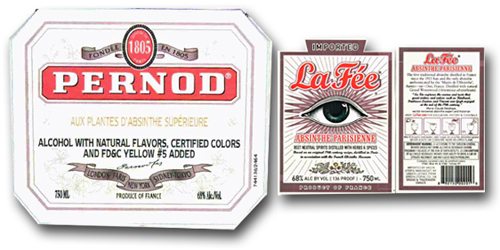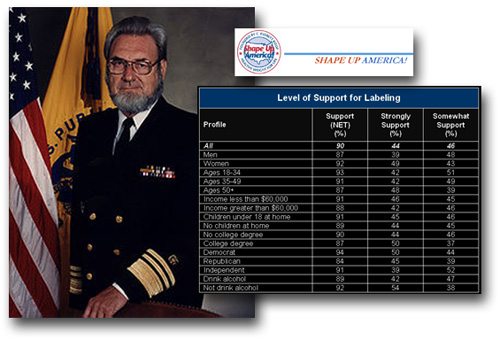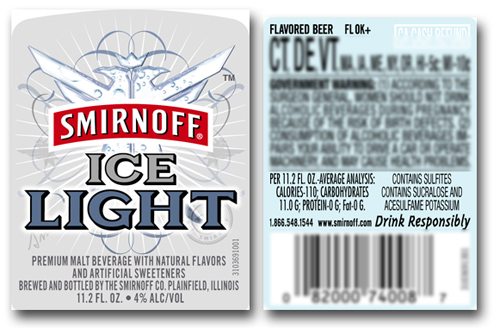This Bacardi Island Breeze label blew in with a bang, in late 2005, and blew out quickly thereafter. Bacardi apparently had big plans for this “lite spirit.” The company booked Kim Cattrall for print and TV ads. But just a few years later, there is almost no trace of this brand or the ads. This label remains significant because it is one of the very few that refers to a Serving Size of 1.5 fluid ounces, and the “USDA National Nutrient Database.” TTB is moving toward requiring this information, in an expanded way, on all alcohol beverage labels. Diageo has pointed to this label and grumbled that it should be allowed to do something similar, too. This product is also one of very few using sucralose as a sweetener.
Continue Reading Leave a Commentpolicy
Serving Facts on Bacardi Island Breeze

Tags: ingredients, legally interesting/controversial, policy, serving facts/allergens
Gallo Beware?

I am pleased to share a guest post, from Paul Jorgensen. Paul is an attorney in Washington, D.C.
For readers thinking of registering a surname as a trademark for their beverage, please consider a recent case by the judicial branch of the U.S. Patent and Trademark Office (PTO), the Trademark Trial and Appeal Board (TTAB). According to In re Hall Wines, Serial No. 78926151 (February 10, 2009), anything that looks like a surname in your mark must be, above all, unique. The PTO usually refuses marks that are surnames, reasoning that if the PTO grants registration to that name, others may be unfairly stopped from using their name on their business, products or services. Since distillers and wineries often think of branding their products with family names, famous names, or names of well-known craftsmen, the resulting marks are frequently refused. So distillers and wineries should have a clear understanding of how the PTO will review their proposed mark. If the PTO thinks your application contains a surname, they will put the proposed mark through four tests, often referred to as Benthin factors after a case with the same name (In re Benthin Management GmbH, 37 USPQ2d 1332, 1334 (TTAB 1995)):
- How rare is the surname? The PTO will research this or...
Tags: legally interesting/controversial, policy, trademarks-beverage
Brewers Association Comment; Top 5 Things to Know

It is likely that all beer, wine and spirits labels will change dramatically in the near future. TTB has been working on new rules since CSPI and other groups submitted a petition in 2003. The new rules would require a “Serving Facts” panel on every container. This panel would include a lot more information, such as the typical serving size, number of servings per container, calories, carbohydrates, protein and fat. Because this is a big, controversial change, TTB has received more than 18,000 public comments during the past few years. There are far too many comments for most people to review, and so we will highlight and summarize the most noteworthy comments here. The most recent proposal and comments are here. This is comment 10 in a series; to see others, click on the “serving facts” tag below. The Brewers Association represents about 1,400 small brewers across the US. The Association’s 29-page comment said:
- Compliance will be expensive and lead to fewer products in the market.
- A 12 ounce serving size makes sense for normal beer, but modern brewing “allows for malt beverages to be fermented over 27% ABV” and for those over 20%, a reasonable serving size would be just 2 ounces.
- 100% of small breweries will be affected by the proposed rule and 38% said...
Tags: policy, serving facts/allergens
Pernod Absinthe

Here (above) is the COLA for Pernod Absinthe, at long last. It was extremely difficult to find, in TTB records, and a lot of absinthe enthusiasts have been looking for the COLA for upwards of a year. For example, Alan Moss’ Real Absinthe Blog does a great job tracking all the US-approved absinthes, but he too was not finding the approval. As of today his blog says “Pernod Aux Extraits de l’Absinthe: announced … for July 2008 launch. … Where is the label approval?” We think it’s fairly interesting that the Pernod label, for some reason, lists CERTIFIED COLORS AND FD&C YELLOW #5 in big text on the front label. But the comparable La Fee absinthe shows “caramel color & certified colors FD&C Blue #1 & FD&C Yellow #5” in much smaller text, on the back label.
Continue Reading Leave a CommentTags: policy, statement of composition, type
Shape Up America Comment; Top 4 Things to Know

It is likely that all beer, wine and spirits labels will change dramatically in the near future. TTB has been working on new rules since CSPI and other groups submitted a petition in 2003. The new rules would require a “Serving Facts” panel on every container. This panel would include a lot more information, such as the typical serving size, number of servings per container, calories, carbohydrates, protein and fat. Because this is a big, controversial change, TTB has received more than 18,000 public comments during the past few years. There are far too many comments for most people to review, and so we will highlight and summarize the most noteworthy comments here. The most recent proposal and comments are here. This is comment 9 in a series; to see others, click on the “serving facts” tag below. Shape Up America! is a non-profit founded by former Surgeon General C. Everett Koop, M.D.; its purpose is to promote a better diet. The group’s comment said:
- TTB’s proposal leaves out critical data such as serving size, alcohol in grams, definition of “standard drink,” and a moderation message. Without this, the proposal will fail as a public health tool.
- The information is important to combat the obesity epidemic and to reduce alcohol-related mortality “which is the third leading cause...
Tags: policy, serving facts/allergens
Sucralose and Ace K

The back label says CONTAINS SUCRALOSE AND ACESULFAME POTASSIUM. The front label says PREMIUM MALT BEVERAGE WITH NATURAL FLAVORS AND ARTIFICIAL SWEETENERS. We think this is noteworthy due to the unabashed use of artificial sweeteners. Perhaps this marks a trend toward a much wider use of artificial sweeteners, in beverages so commonly sweetened with sugar over so many centuries. It is partly a liberalization, on the part of FDA and TTB, allowing a wider variety of sugar substitutes. It may also be due to forward-thinking companies getting way out in front of the eventual need to disclose calories and carbohydrates. IFIC says sucralose is 600 times sweeter than sugar, derived from sugar and:
can be used in place of sugar to eliminate or reduce calories in a wide variety of products. … Sucralose was discovered in 1976. … In 1998, [FDA] approved the use of sucralose in 15 food and beverage categories — the broadest initial approval ever given to a food additive.
Acesulfame Potassium, according to Wiki, is:
Continue Reading Leave a Commenta calorie-free artificial sweetener, also known as Acesulfame K or Ace K (K being the symbol for potassium), and marketed under the trade names Sunett and Sweet One. … It was discovered accidentally in 1967 by German chemist Karl Clauss at Hoechst AG (now...
Tags: ingredients, policy, serving facts/allergens

